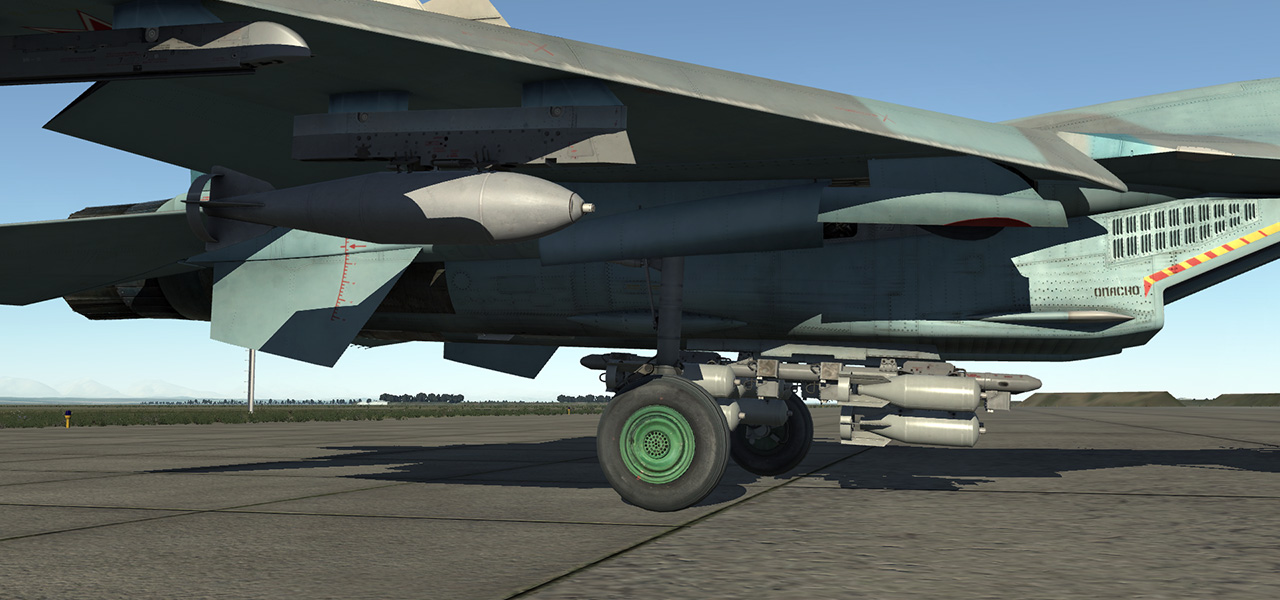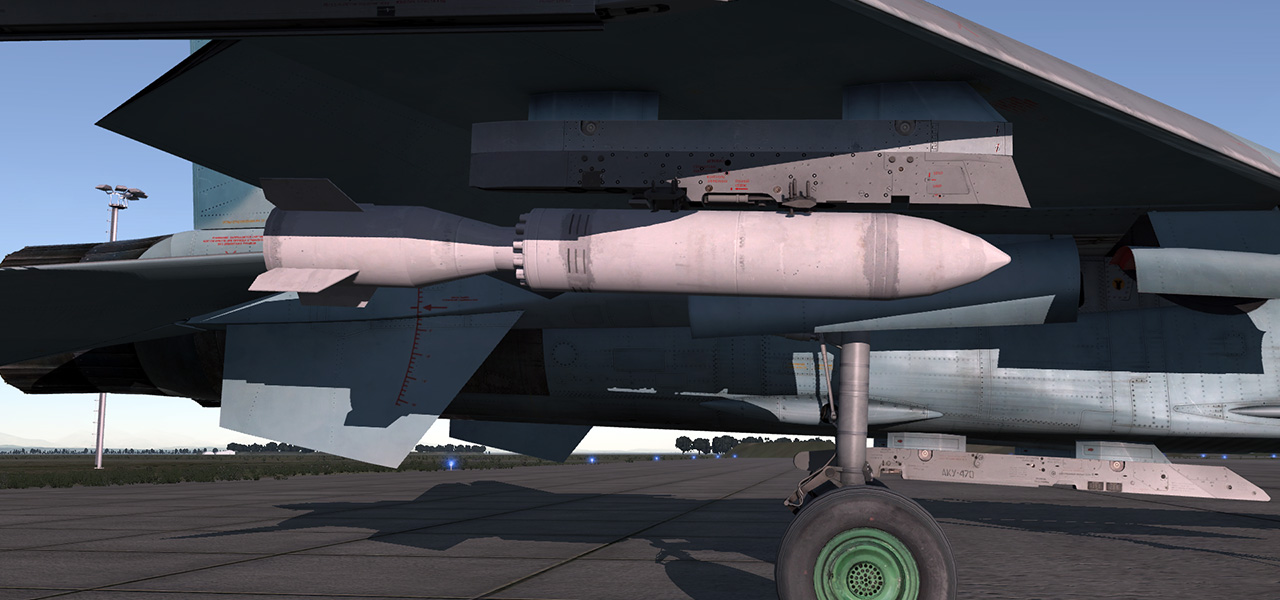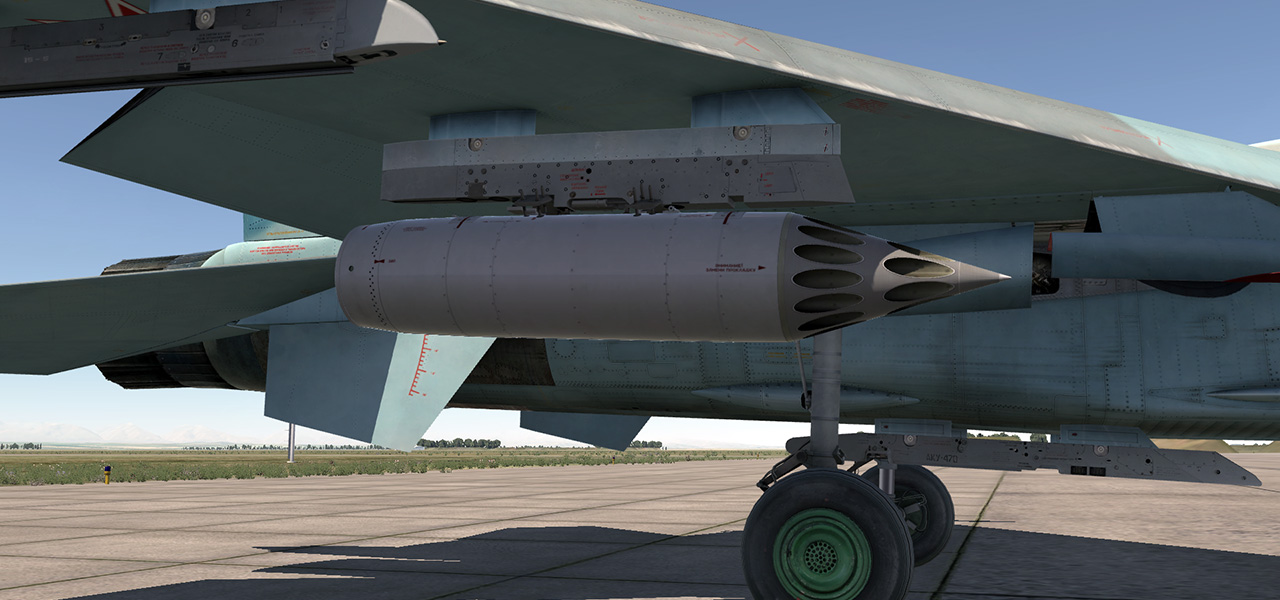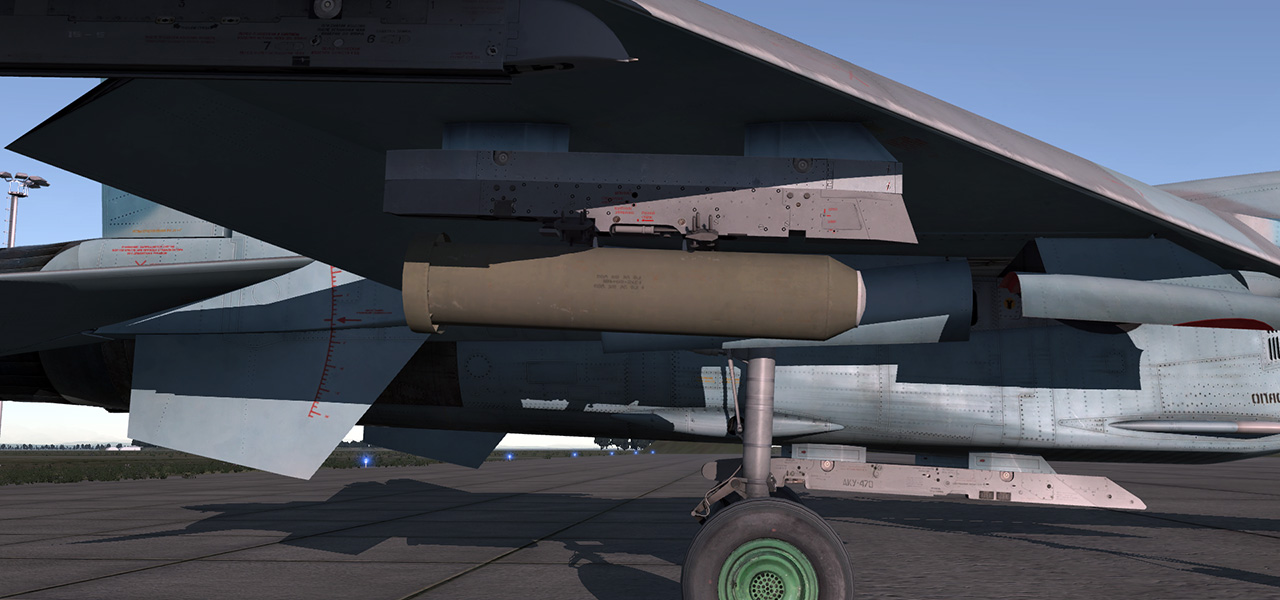The Su-27 (NATO codename Flanker B) is a highly-agile, supersonic, twin-engine air-superiority fighter. A mainstay of modern Russian combat aviation, the Su-27’s primary role is as a long-range interceptor, but it is also a superb dogfighter. The Flanker B can carry up to twelve air-to-air missiles - usually a mix of short range R-73s (AA-11 Archer) all-aspect IR and medium-to-long range R-27s (AA-10 Alamo). It also has a fearsome 30 mm GSh-30-1 cannon and can deliver unguided bombs, CBUs and rockets in the ground attack role.
Equipped with a powerful (‘Slot Back’, Russian ‘Mech’ or ‘Sword’) pulse doppler radar for optimum lookdown-shootdown capability, the Su-27 also has cutting-edge Infrared Search and Track (IRST) for the passive detection and engagement of aerial targets.
Powered by 2 × Saturn AL-31F turbofans each producing 16,910 lbf of dry thrust and 27,560 lbf with afterburner, the Flanker B has a maximum speed of 2,500 km/h (1,550 mph or Mach 2.35) at altitude and 1,400 km/h (870 mph or Mach 1.13) at sea level and a searing 59,000 ft/min rate of climb. The aircraft has a service ceiling of 62,500 ft and an exceptional range of 3,530 km (2,193 mi; 1,906 nmi) at altitude and 1,340 km (800 mi; 720 nmi) at sea level.
Fast, agile and superbly equipped, the Su-27's ability to maneuver at very slow speed and with a high angle-of-attack make it a dangerous opponent in air combat. Take on the DCS: F-15C Eagle - and see who comes out on top. The J-11A aircraft featured in the game is a Chinese variant of the Russian Su-27 with minor radar modifications and the ability to use R-77 active air-to-air missiles.
Su-27 can carry a solid list of non guided bombs and rockets.
High explosive general purpose bombs FAB-100, FAB-250, FAB-500.

Concrete piercing bombs BetAB-500.

Cluster munitions RBK-250, RBK-500, KMGU.

Rockets S-8, S-13, S-25.

Illumination bomb SAB-100.

The Su-27 is controlled by a combination of mechanical and fly-by-wire sub-systems. The longitudinal control is maintained by the synchronous deflection of stabilizers and lateral control is maintained by the differential deflection of flaperons, stabilizers, and rudders. Directional control is maintained by the deflection of rudders.
The mechanical control system is intended for differential deflection of flaperons as part of the lateral control system; synchronous deflection of flaperons during takeoff and landing; rudder deflection during pedal movement; and artificial flight control loading and trimming.
The fly-by-wire system is intended for manual control of the aircraft via longitudinal and lateral channels to provide desired stability and control qualities; to limit angle-of-attack and g load; to control wing leading edges; and for synchronous control of flaperons during maneuvering.
In order to improve maneuvering performance, the Su-27 has a low degree of pitch stability, which resulted in the necessity of using the fly-by-wire system for augmenting control stability of the aircraft.

Longitudinal channel stabilizer control schematic block diagram
The longitudinal channel of the fly-by-wire system has three operational modes:
The TAKEOFF-LANDING and FLIGHT modes of the fly-by-wire system are switched automatically in accordance with landing gear position.
The DIRECT CONTROL mode is switched on if the fly-by-wire system fails. Piloting in this mode requires special care; the flight is characterized by:
When in this mode, compensate for the aircraft’s tendency to change pitch by using short, preemptive stick inputs. Refrain from abrupt, large stick inputs. Angle of attack in this mode should not exceed 10 degrees (the flight envelope limiter does not restrict the angle in this mode); perform turns with a bank no more than 45 degrees.
It is in this mode that the "Pougachev’s Cobra" aerobatic maneuver is performed.
The fly-by-wire system is a trajectory control system. In other words, if the control stick remains in the same position, the system will hold the set flight path. This is why the reduction of airspeed (for example) and resulting decreased lift and increasing angle of attack, will lead to the aircraft attempting to hold the initial flight path and prevent the aircraft from descending. This will result in the airspeed stability degradation up to neutral stability.
The longitudinal control system includes an airspeed trimming law that generates a signal proportional to the ram air. When the indicated airspeed is increased, the FCS causes the stabilizers deflection (up to 5 degrees) nose down. When decelerating, it causes the nose to come up. This imitates the airspeed stability of the aircraft, which is neutral in the presence of a g loading feedback signal. The airspeed stability imitation allows the pilot to use the control stick like he or she would with a stable aircraft.

Stabilizer trimming (ST) – ram-air flow (CAS) diagram
This is a logic law of the FBW and is based on tick longitudinal deflection vs ram air pressure. This control law makes the pilot "feeling" of flying at an airspeed-stable aircraft. The law is also intended to increase the flight safety when decelerating. As the aircraft is neutrally stable by airspeed, it should increase the angle of attack in decelerated flight. The aforementioned control law prevents from this by deflecting stabilizers to decrease the AoA.
When accelerating, to keep the aircraft level, it should be trimmed "nose down" as the airspeed increases.
Roll control is performed by flaperons working as ailerons (flaperons are also deflected down as flaps when in the takeoff-landing mode) and by differential stabilization. With increased angle of attack, the rudders are used to control roll (see Directional channel).

Lateral channel stabilizer control schematic block diagram
The flaperons and rudders belong to the mechanical part of the control system. The lateral channel of the fly-by-wire system, which includes differential control mechanism and roll damper, controls the differential stabilizer deflection.
The differential control mechanism is actuated by side stick inputs and provides differential stabilizer deflection. The degree of this deflection depends on the indicated airspeed and angle of attack.

AoA and CAS correction of the differential stabilizer
Reduction of differential stabilizer deflection as V increases excludes large loads on the fuselage tail section at high indicated airspeeds and their reduction with the angle of attack increase excludes manifestation of roll yaw reversal.
The roll damper provides differential stabilizer deflection by roll rate, and it is intended to counteract short-period, roll oscillations.
As indicated airspeed increases at low-to-medium altitude, the maximum roll rate ωх max is increased, reaching the highest value within an indicated airspeed of 600...800 km/h. Here, the maximum ease of the lateral aircraft control is observed.
With a further increase of the indicated airspeed, the lateral handling gradually deteriorates, which becomes noticeable at airspeeds greater than 1200 km/h.

Roll rate – CAS diagram
Such dependence of the lateral handling based on indicated airspeed is accounted for by the following factors:








